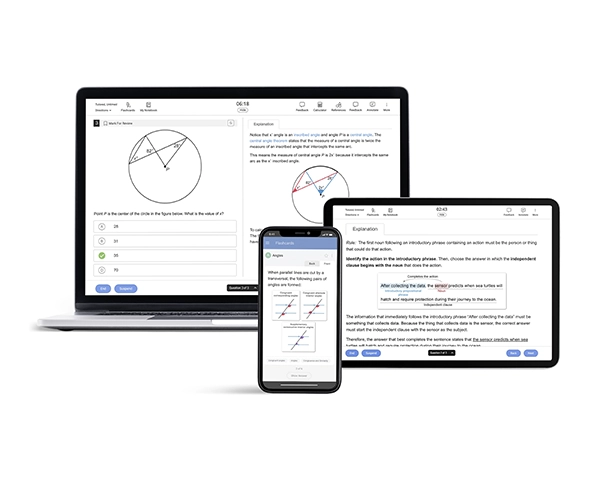If you’re thinking about how to study for AP Macroeconomics over the summer, you’re setting yourself up for success. AP Macro introduces important concepts about how entire economies function—ideas that show up everywhere from stock markets to government policies.
Starting early helps you get comfortable with graphs, formulas, and real-world applications before the pressure of the school year kicks in. It’s a great way to reduce stress, improve your class performance, and boost your chances of earning a 5 on the AP exam. Plus, you’ll start building the foundation for business, economics, finance, and marketing college majors.
In this blog, we’ll show you how to create an AP Macroeconomics summer study plan—and how UWorld’s watch, read, practice method can make your prep both efficient and effective.
Why Prep for AP Macroeconomics Over the Summer?
AP Macroeconomics moves fast and covers a lot of new material—from calculating GDP to analyzing monetary and fiscal policies. If you wait until fall to start learning, it can be overwhelming to juggle everything at once.
Benefits of Summer Prep:
- Master foundational concepts like opportunity cost and aggregate supply/demand early
- Get comfortable with graphing shifts, curves, and economic models
- Build real-world connections to current events and financial markets
- Increase confidence for class discussions and free-response questions (FRQs)
- Improve your chances of scoring a 5 on the AP exam
Even studying just a few hours each week this summer can give you a serious advantage heading into the school year.
The “Watch, Read, Practice” Method for AP Macroeconomics
UWorld’s watch, read, practice AP Macroeconomics method is designed to help you study smarter, not harder. It breaks down the material into simple, active steps that actually stick.
Step 1: Watch – Break Down Key Concepts in Short Video Lessons
Start each session by watching UWorld’s AP Macroeconomics video lessons. These animated videos explain major concepts using visuals, real-life examples, and step-by-step walkthroughs.
Topics to Prioritize Early:
- Basic Economic Concepts (scarcity, opportunity cost, comparative advantage)
- Supply and Demand
- Measuring Economic Performance (GDP, inflation, unemployment)
- Aggregate Demand and Aggregate Supply Models
Each video focuses on a single topic, making it easy to build knowledge one step at a time without feeling overwhelmed.
Step 2: Read – Reinforce What You Learned with the Study Guide
After watching, dig into the UWorld AP Macroeconomics Study Guide. It’s designed to make tough ideas simpler, with clear explanations, colorful graphs, and quick knowledge checks.
How to Use It:
- Read the matching section after each video
- Focus on key graphs, definitions, and real-world examples
- Summarize concepts in your own words to check your understanding
The study guide is fully aligned to the College Board’s official AP Macro curriculum, so you’re always studying what matters most.
Step 3: Practice – Apply Your Knowledge with QBank Questions
Once you’ve watched and read, lock in your learning with UWorld’s AP Macroeconomics QBank questions. These practice problems are designed to feel like real AP exam questions, helping you strengthen both your content knowledge and test-taking skills.
Each question includes:
- Detailed answer explanations
- Visual graphs and diagrams
- Hints on how to avoid common mistakes
How to Practice Smart:
- Start with 5–10 practice questions per session
- Carefully review explanations, even for questions you got right
- Track any tricky topics for future review sessions
Practicing actively now will make FRQs and multiple-choice tests feel much more manageable later.
Sample AP Macroeconomics Summer Study Plan
Here’s a flexible, beginner-friendly AP Macroeconomics summer study plan you can adapt to your summer schedule:
8-Week Sample Plan
| Week | Topics | Plan |
|---|---|---|
| 1 | Introduction to Economics | Watch 2–3 videos, read the guide, do 10 QBank questions |
| 2 | Basic Economic Models | Focus on opportunity cost, production possibilities |
| 3 | Supply and Demand | Learn market equilibrium and elasticity |
| 4 | Measuring Economic Performance | Study GDP, unemployment, and inflation |
| 5 | Aggregate Demand and Aggregate Supply | Understand shifts and their impact |
| 6 | Fiscal Policy and Multiplier Effects | Explore government spending and taxation |
| 7 | Monetary Policy and Banking | Review money creation, the Fed, and interest rates |
| 8 | Review Week | Take a practice set, focus on weaker areas |
With just 2–3 study sessions per week, you’ll build a strong foundation without sacrificing your summer fun
Why Macroeconomics Matters for Business and Finance Majors
If you’re aiming for a future in business, marketing, finance, or economics, AP Macroeconomics is a game-changer. Understanding how policies affect inflation, interest rates, and unemployment will help you:
- Analyze market trends
- Make smarter financial decisions
- Build strategic thinking skills
- Succeed in college-level econ and finance classes
Starting early helps you not just memorize terms, but also think like an economist or business person.
Final Thoughts: Get Ahead, Stress Less
Studying AP Macroeconomics over the summer doesn’t have to be overwhelming. With the right approach, a little bit of consistent effort can give you a major head start.
Using UWorld’s watch, read, and practice method, you’ll be able to:
- Understand economic concepts clearly
- Practice applying them in real-world scenarios
- Build confidence for in-class tests and the AP exam
Start Strong with UWorld AP Macroeconomics Review Tools
With short video lessons, a complete study guide, realistic QBank questions, and a customizable study planner, UWorld has everything you need to prep for AP Macroeconomics this summer—without the stress.
Start early. Study smart. Walk into class ready to crush it!




